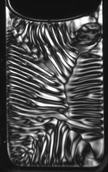Wednesday, August 09, 2006
How Life takes Shape: Microtubules and Pattern Formation

Providence, Rhode Island - How life takes shape is a mystery. Butterfly or baby, cells organize themselves into tissues, tissues form organs, organs become organisms. Over and over, patterns emerge in all living creatures. Spiders get eight legs. Leopards get spots. Every nautilus is encased in an elegant spiral shell.
This phenomenon of pattern formation is critical in developmental biology. But the forces that govern it are far from clear. Alan Turing, father of modern computer science, suggested that the basis for pattern formation was chemical. New research .. supplies another surprising answer: Physical, as well as chemical, forces can dictate pattern formation.
In a two-year study (Abstract of Microtubule bundling and nested buckling drive stripe formation in polymerizing tubulin solutions), Brown physicists James Valles and Jay Tang puzzled over the patterns created by proteins called microtubules. Shaped like long, skinny straws, these proteins are puny - they measure only about 250 atoms wide - but play critical roles in the body. Microtubules help cells divide. They also act as scaffolds, giving cells their shape, and serve as train tracks of sorts, moving important bits like chromosomes and mitochondria around inside of cells.
technorati tags: providence, rhode+island, life, shape, mystery, butterfly, cells, organisms, pattern, spiders, leopards, nautilus, formation, developmental, biology, alan+turing, computer+science, research, proteins, microtubules, chromosomes, mitochondria
Add to: CiteUlike | Connotea | Del.icio.us | Digg | Furl | Newsvine | Reddit | Yahoo